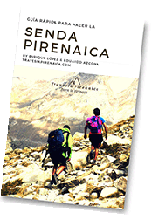Is it necessary to carry an ice axe and crampons for the GR11?

In early June, depending on the season, there may be numerous snowy passes in the Central Pyrenees that require the use of ice axes and crampons. In recent years, from July onwards, there are hardly any more places where they are needed. In any case, on uncertain dates, it is a good idea to check the snow conditions on some of the passes such as Tebarray, Noucreus or Ixalenques (GR11.5).
We all want to go ultralight, especially if we are going to do a long trek, such as the GR11 Senda Pirenaica. But sometimes, carrying a little less weight means taking more risks: should I take my crampons and ice axe? How will those cols be? Will I find snow?
I know, it is a nuisance to carry those heavy bags if we are only going to use them for a short time on our route. But just think that a slip, a slip on a snowdrift, which can be just a few metres, can mean an accident that, in many cases, can be fatal in the mountains. Therefore, it is necessary to evaluate: do we want to go very light? Well, maybe the best time to do the route should be in the summer. If not, it is logical that at certain "critical" points of the route - I can list five or six, but we will go into more detail later - there may be problems.
Specific areas where it may be necessary
Points of the route to be taken into account:
- Ibones de Anayet [Stage 12: Candanchú - Sallent de Gallego]
- ⚠️ Collado de Tebarray or Piedrafita pass (2,771m). [Stage 14: Respomuso Hut - Panticosa Spa] The Tebarray pass can have snow until mid-August. In the last 50 metres the slope is around 40º, so the ice axe is recommended depending on the conditions. In winter, the access route to the Respomuso refuge may present a high risk of avalanches.
- Cuello Alto de Brazato / Puerto Viejo (2,566m). [Stage 15: Panticosa Spa - Bujaruelo]. The Cuello Alto de Brazato can have snow until July. If this stage is done in early summer or late May, when the snow reaches the Brazato Reservoir, the use of ice axes will be necessary to climb the slope below the reservoir. The route is well signposted.
- Añisclo pass (2,453m) [Stage 17: Góriz - Pineta (via the Fuen Blanca)The alternative via Faja de las Olas is not recommended in snowy or icy conditions]. The final descent to Pineta is probably the steepest descent of the GR11.
- Chistau Pass (2592). [Stage 20: Biadós Hut - Bridge of San Jaime]
- Vallibierna Neck (2710m). [Stage 21: San Jaime Bridge - Cap de Llauset Hut] From the Vallibierna lakes we enter the high mountain terrain. The path disappears, it is difficult to walk between the blocks and we can find snow at the beginning of summer in the Cuello de Vallibierna.
- Col of Eriste or Forqueta (2,860) (GR 11.2) [Stage 20v: Biadós Hut - Angel Orús Hut] The Forqueta pass may have snow at the beginning of the season. The descent to the Llardaneta lake is very steep.
- ⚠️ Coll de Salenques/Ixalenques pass (2,809m). (GR11.5). [Stage 22v (GR11.5): La Renclusa hut - Cap de Llauset hut] The Salenques pass usually has a snowpack that persists all year round (crampons essential). In October 2017 this was not the case, but the small snowdrift that still remained was pure ice. Another option when there is still snow at the end of summer is to climb the rocks on the right.
- ⚠️ Noucreus pass (2,790m) [Stage 38: Nuria Sanctuary - Ulldeter Hut]
Don't underestimate the terrain, if you have to carry safety equipment, you have to carry it. An icy snowfield, as I said at the beginning, can be a death trap. On one occasion, on the GR11 route -Collado de Tébaray, towards Ibones de Bachimaña-, I witnessed how a young boy slipped in the most innocent way down a snow pit and the initial laughter of the group, who were watching their companion slide down an improvised slide, turned to screams of shock when he got stuck and spun out of control, with a final impact on the rocks. The reality is that he could have dodged the snowpack on a side path, but he underestimated it. It all turned out to be a minor scare and mishap, but it could have been a different story.

Quick guide
GR 11
with everything you need to know before undertaking the Pyrenean Path
Don't miss any adventure in the Pyrenees!
